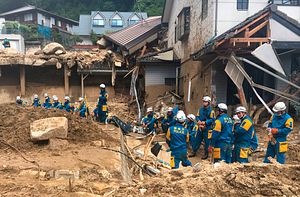In west Japan, residents are picking up the pieces of what remains of their homes after record-breaking torrential rain battered the region, claiming at least 157 lives and leaving 57 people missing. The Ministry of Health estimates 8,400 people remain in evacuation shelters, unable to return to flooded homes, while 254,000 households in Hiroshima and Okayama are suffering from water outages. Receding waters in some districts are giving people a headstart to clear away damage but the lack of water supply is hindering cleaning efforts.
On Thursday, a large rain trough swept over the region, bringing heavy rainfall that triggered flash flooding and landslides across 15 prefectures — a large-scale disaster not seen since 1982. Hiroshima and Okayama were among the hardest-hit regions alongside neighboring Tottori, Ehime, Kochi, Fukuoka, Saga, Nagasaki, Gifu, Kyoto, and Hyogo prefectures. Some cities within Okayama prefecture saw flooding of nearly 30 percent of the total area, while the number of partially or fully destroyed homes nationwide exceeds 10,000.
The township of Fuchu in Hiroshima, which was worst affected by landslides and floods, was ordered to evacuate just after 10 a.m. on Tuesday after the banks of the Enoki River running through the town burst, signalling the disaster is far from over. Rescue efforts are underway as overflowing water filled with debris and mud is currently flooding homes.
The Japan Meteorology Agency issued fresh alerts for mountainous prefectures as the number of disaster victims climbs in areas inundated with rainfall over a long period of time — posing a higher risk for deadly landslides. Three days since the disaster struck, Japan’s Self-Defense Force, firefighters, and rescue dogs are working against time searching through debris for survivors.
Landslides have made some areas inaccessible, hampering efforts to repair essential infrastructure needed to restore power to homes. The Ministry of Land reports that blocked roads and national highways as well as damaged railway tracks affecting 29 rail routes are slowing the distribution of food and supplies from east Japan. Supermarkets and convenience stores are also closed due to disrupted deliveries from road closures. Meanwhile, automakers have suspended manufacturing in Kyoto and Osaka and Mazda has suspended operations in Hiroshima, citing the delayed delivery of parts and the difficulty in getting people to work.
During peak rainfall over the weekend, evacuation orders applied to 5 million residents. Japan’s Meteorology Agency lifted its special torrential rain emergency warning on Sunday night, with weather conditions easing. However, residents are being warned to stay vigilant against heat stroke as the temperature is set to reach 34 degrees Celsius on both Tuesday and Wednesday.
A government task force was established to speed up recovery to the worst affected areas. Two billion yen ($18 million) had been pledged to deliver emergency food, water, and relief essentials such as toiletries, air conditioners, and temporary bathing facilities.
On Monday, Japanese Prime Minister Shinzo Abe cancelled an overseas trips to Brussels (where he was set to sign a free trade deal with the EU) as well as France, Egypt, and Saudi Arabia in order to assess disaster-struck Okayama prefecture on Wednesday. But the government is fending off criticism that it showed a lack of urgency to initial disaster reports after photos on Twitter surfaced on Monday revealing senior cabinet members drinking together on Thursday night, at a time when downpours intensified, displacing tens of thousands of people.

































